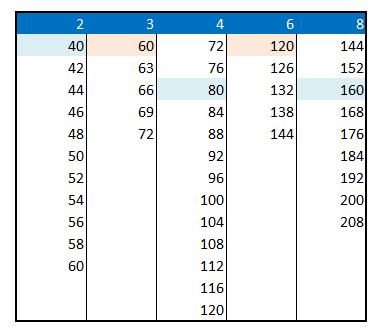Over the years I've had to remind myself that most of my students belong to a different generation, and that what I say to them might mean something different to them than it does for me. One such example is metronome markings: when I tell my students to practice an excerpt at one tempo several times and then to go up one notch, for them it means to go, let's say, from 80 to 81 bpm, whereas for me it means to go from 80 to 84 bpm. Here is why.
Since I grew up practicing with a mechanic metronome, I had no chance of going up or down by only one number. Even my first digital metronome had a scale that mimicked that of a mechanical metronome. These metronomes still exist, but most of my students have, as I do, a digital metronome or a phone app where you can go up or down by one number.
Here is the scale that mechanical metronomes have:
(As mechanical metronome markings go up, the jumps by which they increase widen. The top numbers: 2, 3, 4, 6 and 8 are the bpm added to each row to obtain the subsequent numbers for that column)

Why do I think this metronome scale is better suited for practicing?
Let's say that I'm practicing the first movement of the Concerto for Flute and Orchestra by Jacques Ibert and that my goal is to play it at Quarter Note = 120, as suggested in the score. I believe that it's a waste of energy going from 100 - 120 one step at the time, which would take practicing it 21 times, once at each of the different tempo markings. I would rather practice it at 6 different discrete tempo markings: 100, 104, 108, 112, 116, and 120 until mastering each one of them. That's also the methodology that I expect my students to follow.
That doesn't mean that it's forbidden to go in the above-mentioned example from 116 to 118 or 118 to 120, but that those fine tuning markings are reserved for the end of the process, rather than its beginning. Moving 1 or 2 bpm at a time sometimes can help us when we get stuck in a tempo marking and cannot jump to the next notch.
Historical Note: The metronome was invented by Dietrich Nikolaus Winkel in Amsterdam in 1812. Johann Maelzel copied Winkel's ideas and improved them. He made a small, portable metronome which was patented in 1816.
